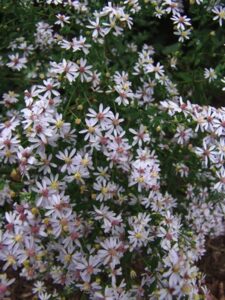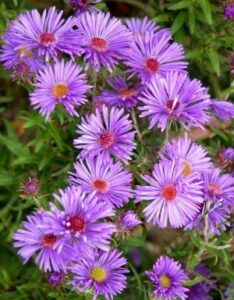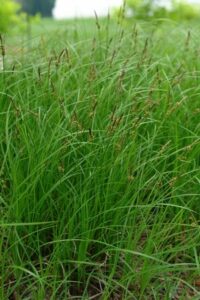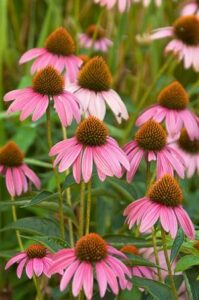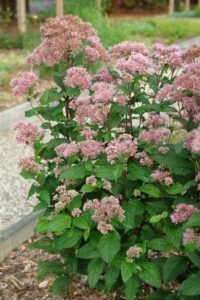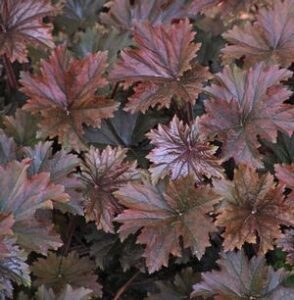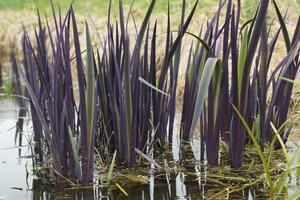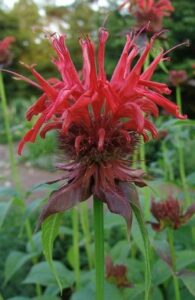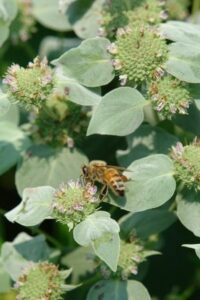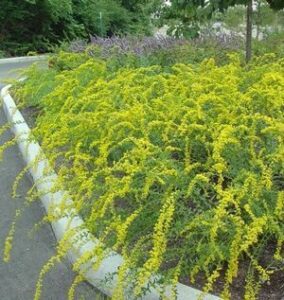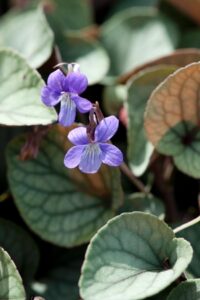Introduction
One of the benefits of membership in the Friends of The Frelinghuysen Arboretum is an annual plant dividend for each of our members. The selections for this year are described below and will be available for pickup at the Plant Sale Members Only Preview Party on Friday, May 3rd (click the link for more information and to register for the Preview Party), as well as at the public Plant Sale on Saturday May 4th and Sunday May 5th .
You can make your choice at the Landscape Plug tables in the tent which will, of course, be subject to availability at the time of selection.
This Year’s Selections
Aster cordifolius – blue wood aster (Symphyotrichum cordifolium)
Clouds of blue flowers in early fall in shade! A great naturalizer under trees, at the edge of woods, or as a filler among Hostas and Astilbes, which look pretty rough by September. Found in woods and dry meadows.
Renamed Symphyotrichum cordifolium, it has a purple to off white daisy-like flower and yellow centers.. Plant spreads by seed and rhizomotously in a vigorous manner making them an excellent plant en masse. More info.
Aster novi-belgii – New York aster
Unlike other aster species, Aster novi-belgii, or New York aster, prefers a consistently moist, humus-rich site. This northeastern native aster can be found rambling along roadsides, ditches, or along wild areas. The flowers possess fewer rays with a lighter violet color than New England aster and has a smooth, almost glabrous leaf.
It provides excellent late season color with occasional white flowers as well as purple with cheerful yellow centers. More info.
Carex pensylvanica – oak sedge
With its tough disposition and spreading habit, Carex pensylvanica makes an excellent shade groundcover. Fine texture and fountaining habit give this sedge a soft appearance that is lovely as an underplanting for bolder shade perennials or on its own as a shade lawn.
A very easy to grow sedge that tolerates Black Walnut, it does well as a lawn substitute or as a shade border edging plant. Happy in the company of oaks. More info.
Echinacea purpurea – purple coneflower
One of the great butterfly magnets of the native perennial garden! Coneflowers are easy to grow in average to dry, well drained soils. Flowers with large orange gold spiky centers and strong reflexed rose pink petals appear in July and August. Very drought tolerant.
The poster child for the native plant movement. A wonderful plant to naturalize in the garden or planted in mass for a powerful and colorful statement in August. More info.
Eupatorium dubium ‘Little Joe’ – Joe Pye weed
Covered in dusty pink blooms in late July through September, ‘Little Joe’ is a fantastic scale for the garden or in a container and has become an industry standard when a Eupatorium is needed in a designed setting. Coming in at 4’- 5’ high, it spreads slowly to 3’ wide over a few years.
‘Little Joe’ has excellent flower power, disease resistance, and habit. Thrives in moist, fertile soils. Cut back in early spring and fertilize to promote bushier growth. More info.
Heuchera villosa ‘Bronze Wave’ hairy alumroot, coral bells
A native late-flowering groundcover. This has much shinier, almost lacquered looking foliage vs. H. villosa ‘Purpurea’. Like its cousin ‘Autumn Bride’, ‘Bronze Wave’ is sturdy, perhaps an 18″, or a bit larger, clump. September-October flowering spikes of small tan flowers. Excellent shade groundcover that can happily compete with tree roots and come out looking good.
Grow in part sun to full shade in moist or average soil. Water well on planting and regularly until established. Trim to crown in late fall. More info.
Iris versicolor ‘Purple Flame’ – blueflag
An extraordinary performer in Mt. Cuba’s gardens, Plant ’Purple Flame’ along the water’s edge, where roots receive consistent moisture to achieve best early season color before foliage slowly transition to green. Beyond other Iris selections on the market, ‘Purple Flame’ has a richer, more intense cast to stems and flowers However, the true beauty lies in the irresistible foliage. Emerging in March, the purple flame-like foliage provides an unparalleled performance of vivid and intense eggplant purple foliage followed by an encore of rich and abundant flowers. More info.
Monarda didyma ‘Jacob Cline’ – beebalm
This drop-dead red variety was found growing wild near the Blue Ridge Parkway by a Georgia plantsman who knew he had a good thing when his discovery proved to be quite the powdery mildew resistant strain. With its wonderfully aromatic foliage, typical mint family square stems, and enormous red tubular flowers, Monarda ‘Jacob Cline’ is a show stopper as it blooms from late June to August. Growing 3-4’ tall and 2’+ wide. More info.
Pycnanthemum muticum – clustered mountain mint
We love this Mountain Mint! Its leaves are broader and more lustrous than Pycnanthemum virginianum, the bracts are silvery and very showy, the flowers are pinkish and its habit is more compact. Nicely aromatic. This native is happiest at the wood’s edge, so it is excellent for a naturalized border or woodland garden.
Mountain Mint is one of the best nectar sources for native butterflies, so butterfly gardeners can’t do without this one. More info.
Solidago ‘Solar Cascade’ – goldenrod
Delightful, golden-yellow flowers are borne in axillary clusters along reflexing stems from late summer into fall. Reliable, deep green, glossy foliage remains clean throughout the growing seasons. Not an aggressive runner, ‘Solar Cascade’ is a clump forming perennial reaching knee height, maxing out somewhere between the taller ‘Fireworks’ and more compact ‘Golden Fleece’. Performs best in moist to average garden soil under full sun or partial shade; extremely drought tolerant once established. More info.
Viola walteri ‘Silver Gem’ – prostrate blue violet
From the gardens of Mt. Cuba Center, North Creek is delighted to introduce this tough native groundcover. Easily identified by trailing stems and delicate lavender flowers, ‘Silver Gem’ forms a dense, tidy mat of attractive silver foliage. Flowers appear in March and persist into autumn. Our plant trials have proven ‘Silver Gem’ to be exceptionally drought tolerant and happiest in part to full shade. More info.
